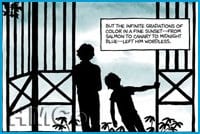Alison Bechdel has been writing and drawing Dykes To Watch Out For since 1983. The strip appears in 50 alternative newspapers (including this one) and is available in book form. If that’s not enough, there’s Bechdel’s blog, Dykestowatch-outfor.com, which offers a fascinating glimpse into the life of a somewhat eccentric lesbian cartoonist.
Now there’s Fun Home, Bechdel’s graphic memoir of growing up in small-town Pennsylvania during the 1960s. All of the elements that make the strip so appealing — the vivid visual details, the melodrama of everyday lesbian life, the current events, the sly political commentary and, of course, the humour — are present in the memoir. There’s the added bonus of a life story that is so loaded up with unexpected drama that it demonstrates the cliché that life is far stranger than fiction.
The story of Bechdel’s childhood is centred around her father. He taught English at the local high school and was obsessed with restoring the century-old family house. He was also a closeted homosexual who had sex with teenage boys, and may or may not have committed suicide at the age of 44. In a Six Feet Under twist, he also ran the Bechdel Funeral Home, the Fun Home of the title, like generations of Bechdel’s before him. Bechdel’s mother, also an English teacher, was a thwarted musician and a passionate performer in local theatre who knew about her husband’s sexual orientation but did her part to bolster the façade of normal nuclear family life.
Bechdel narrates the story of her childhood with great panels, like Alison being called away from watching cartoons on TV with her brothers in order to help her father hang an antique mirror in her bedroom. The details are nothing short of amazing and the illustrations are powerfully vivid.
In the brief preface to the book, Bechdel admits to being to “a careful archivist of my own life” and this practice pays off in the memoir. She describes her process as one of recreation rather than one of imagination. The drawings don’t come out of her head; instead “in order to achieve the level of detail I wanted the images to have, I had to create reference photos of myself, posing as all the characters, in all the drawings.” There is something obsessive about this approach (she admits to keeping ticket stubs and sugar packages) but the results are so impressive.
Bechdel situates herself as an observer of life within her family (all those photographic recreations paid off) and not simply as the centre of the story. Sure it’s all about what she remembers, doesn’t remember or reconstructs after the fact but she works extremely hard to make both of her parents fully dimensional. Her father is cold and distant in many ways, yet he exerts an incredible force over the members of his family and it’s not all bad. She makes the reader feel compassion for a man whose unhappiness was palpable and who clearly didn’t fit in his surroundings and couldn’t make the move to get out.
The portrayal of her mother is similarly nuanced. She comes across as classic ’60s woman, full of the contradictions that go with settling for an unhappy marriage in a small town, swallowing her theatrical ambitions and trying to conform to so-called normal family life. Her reality was anything but normal, but again, the pressures of the era prevailed.
Much of Fun Home resembles a typical coming of (lesbo) age in the late ’60s with the Watergate hearings dominating the airwaves followed by going to college and coming out as a lesbian in the early heady days of gay and women’s liberation. But Bechdel renders the unique twists that make up her particular story with much insight, seriousness and sensitivity which gives it an edge over others in the genre.

 Why you can trust Xtra
Why you can trust Xtra


